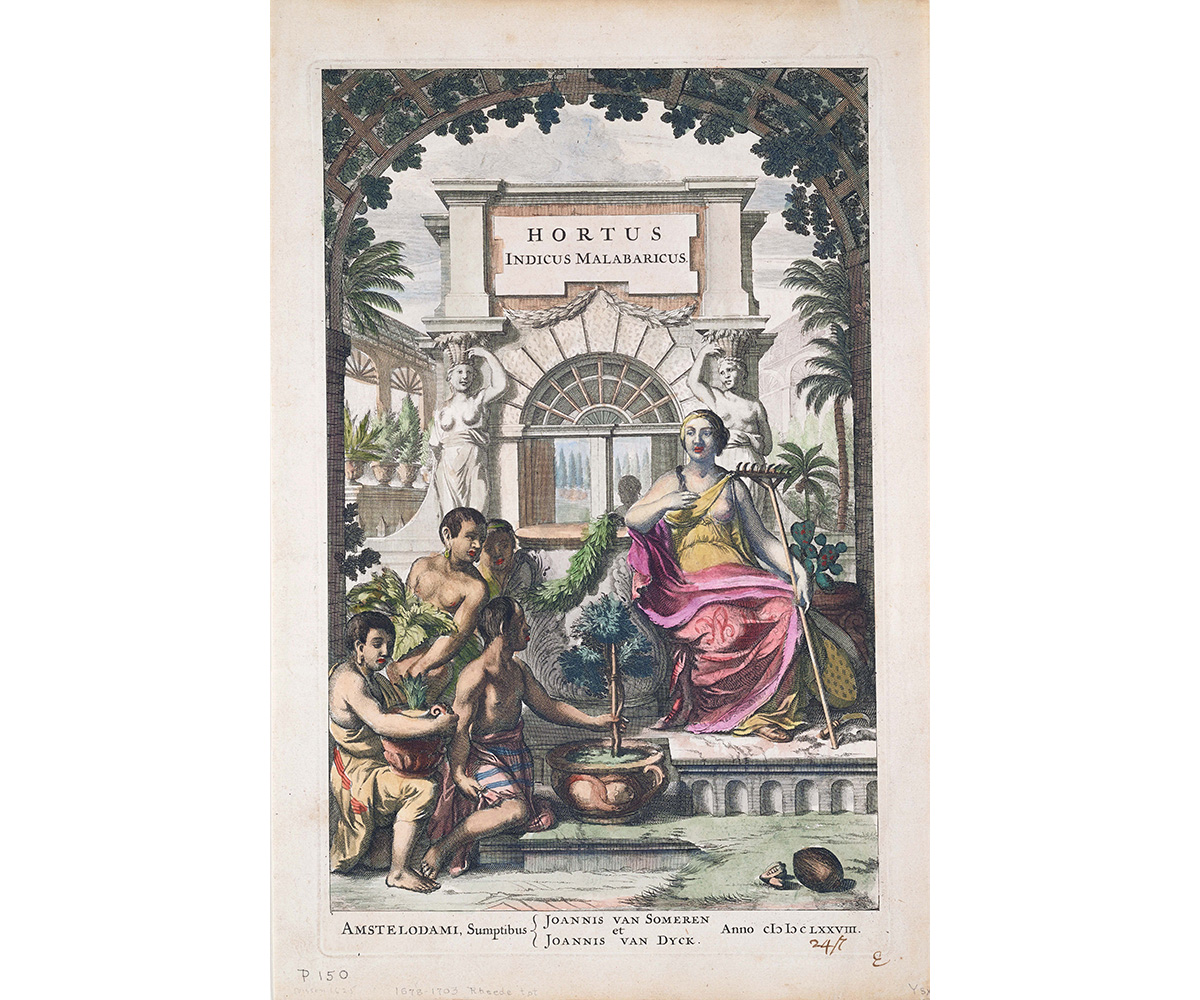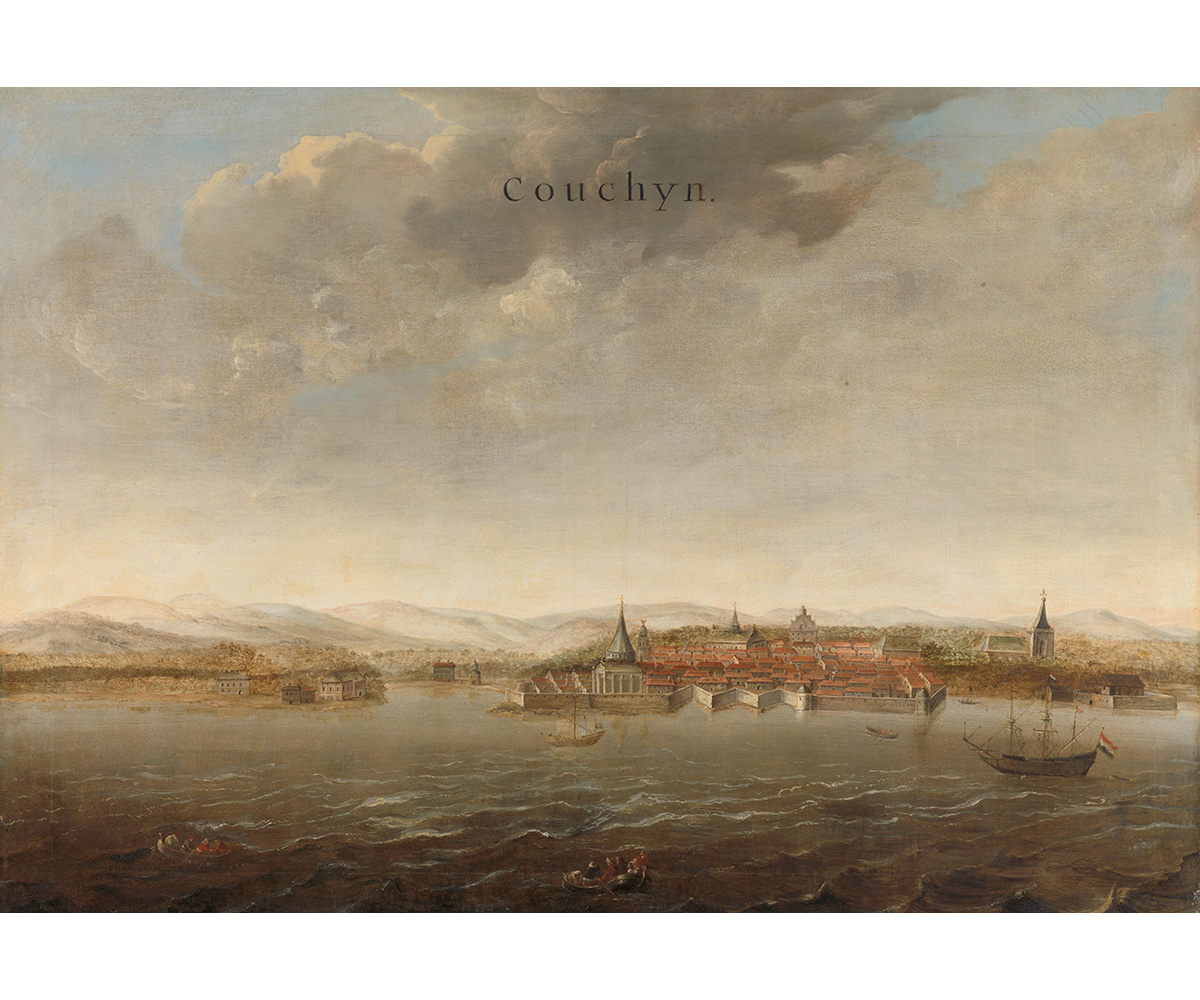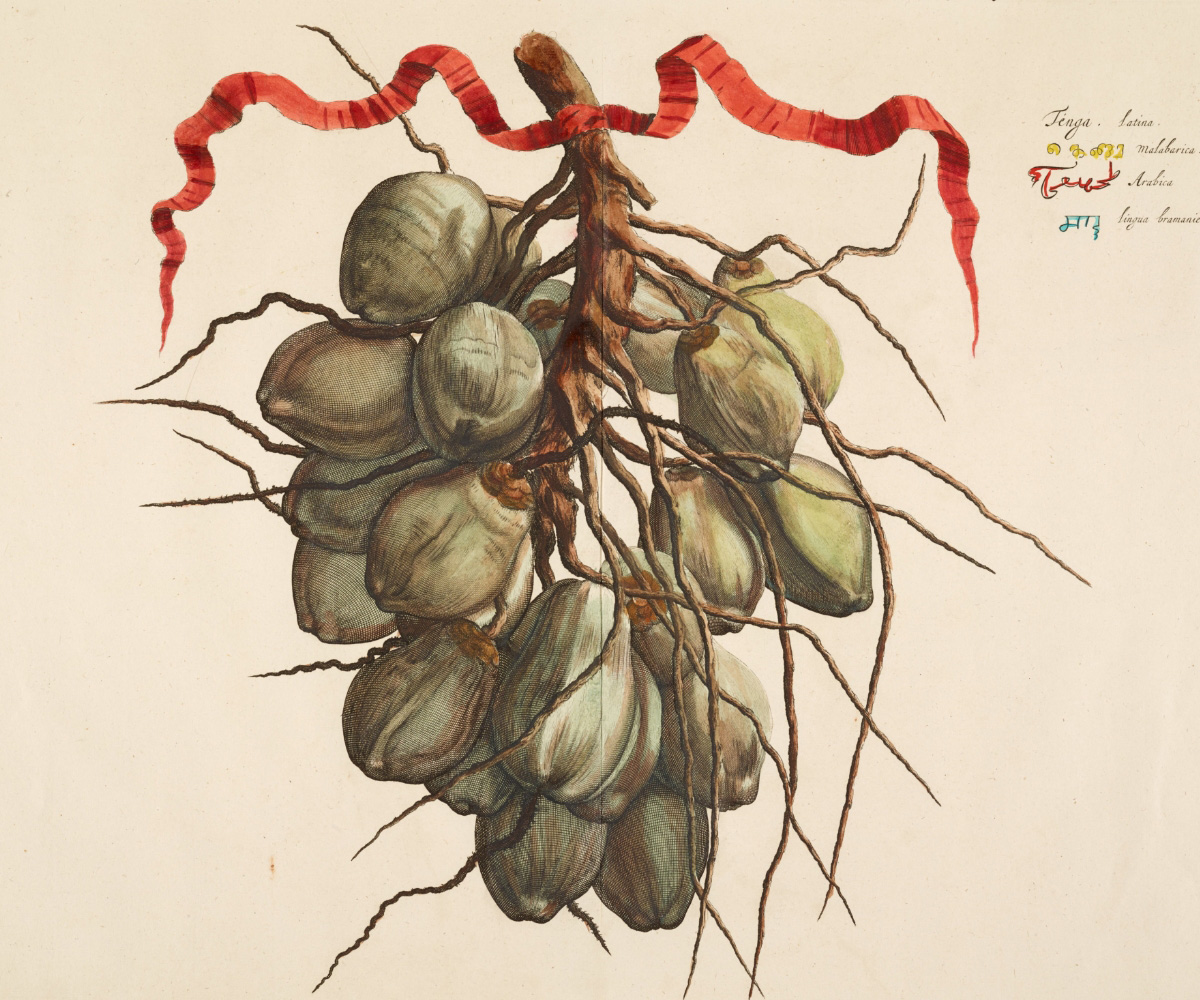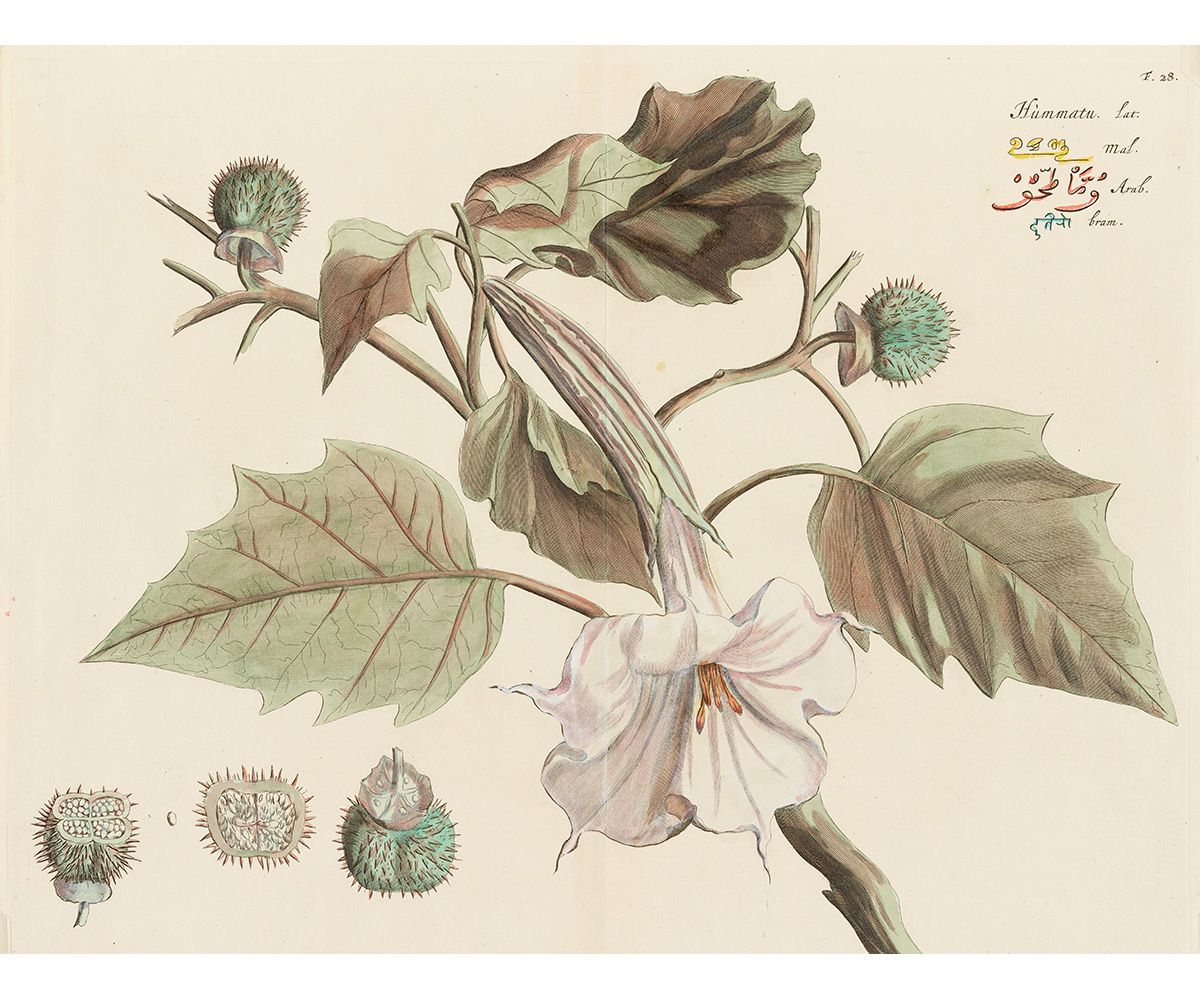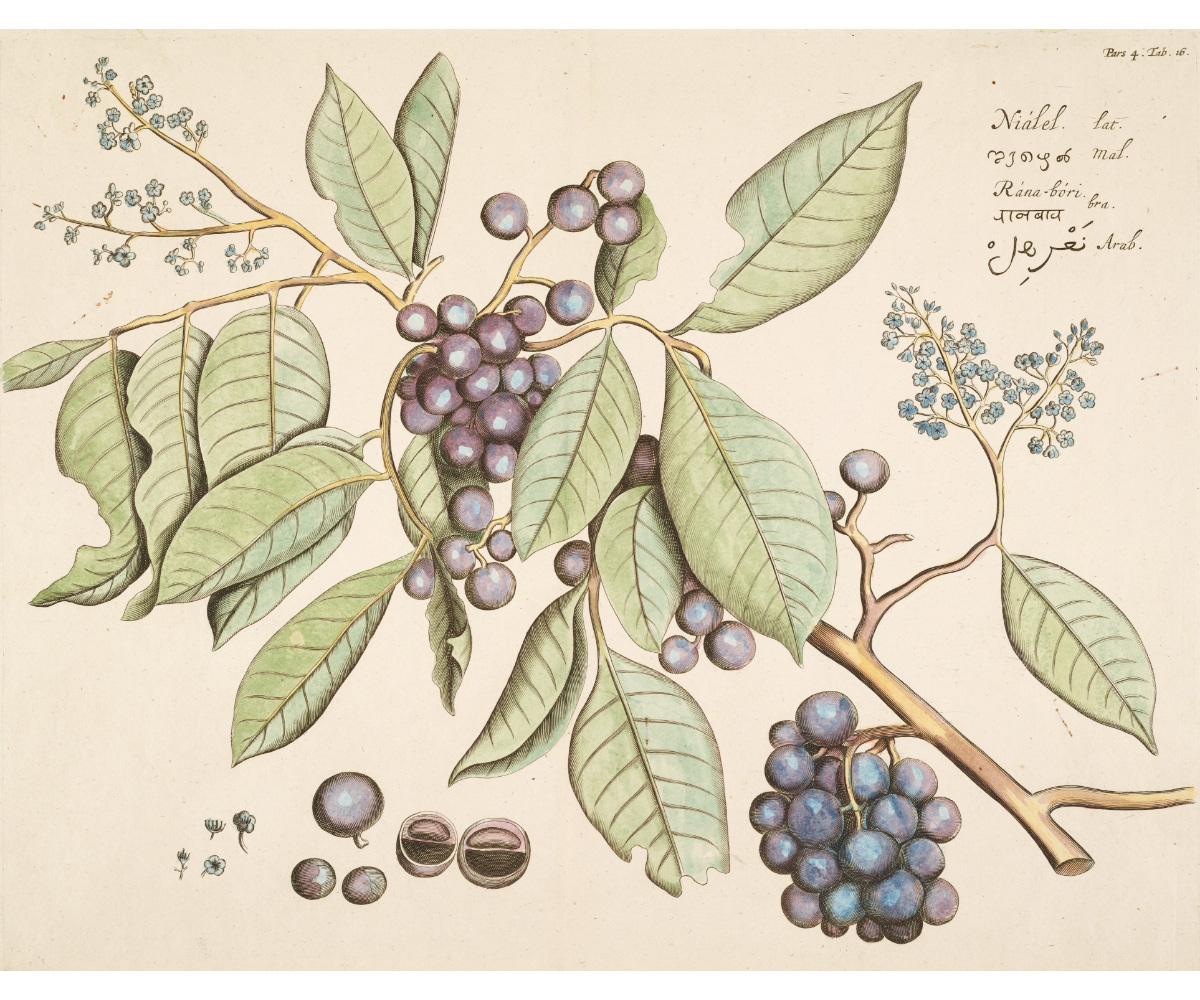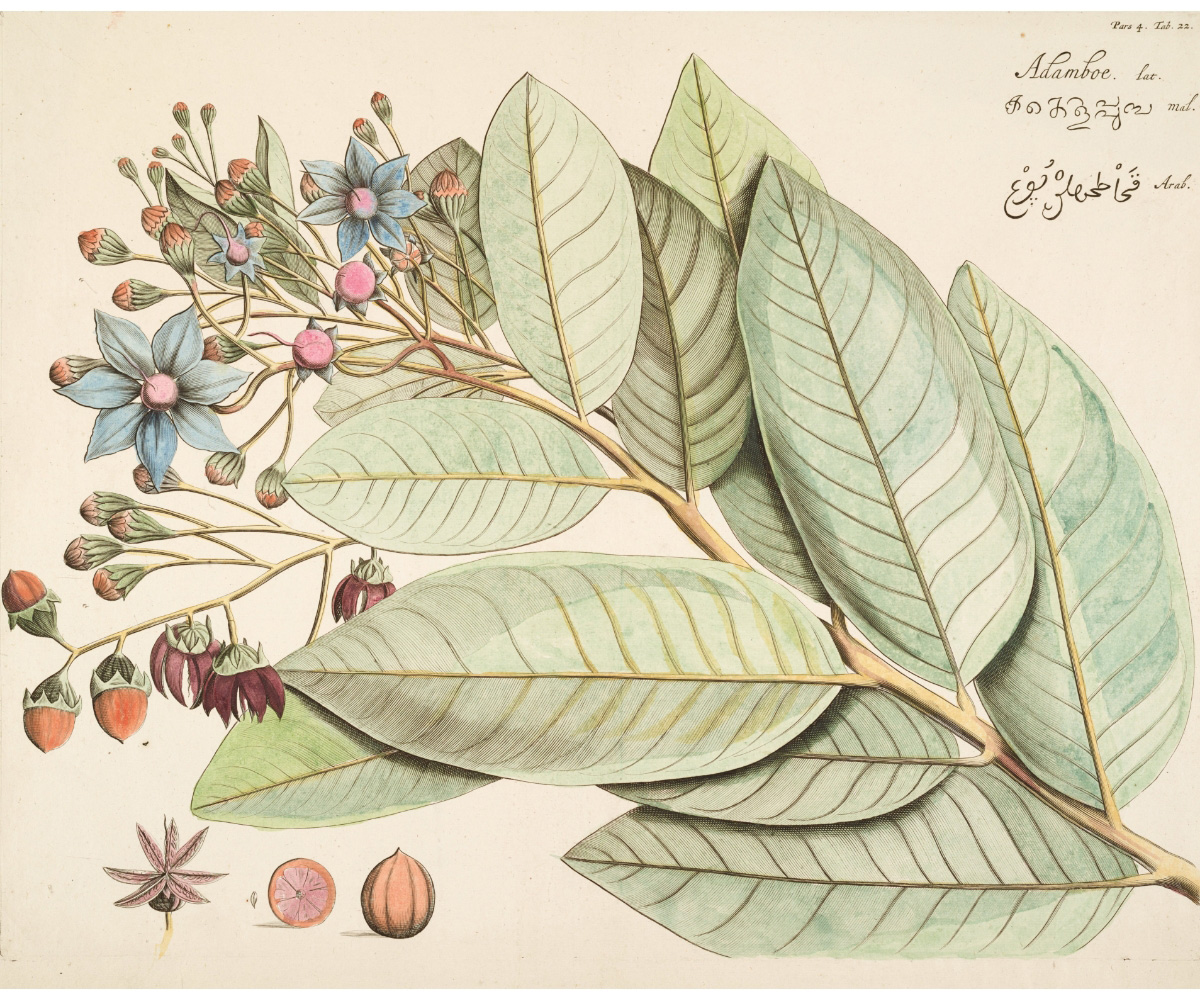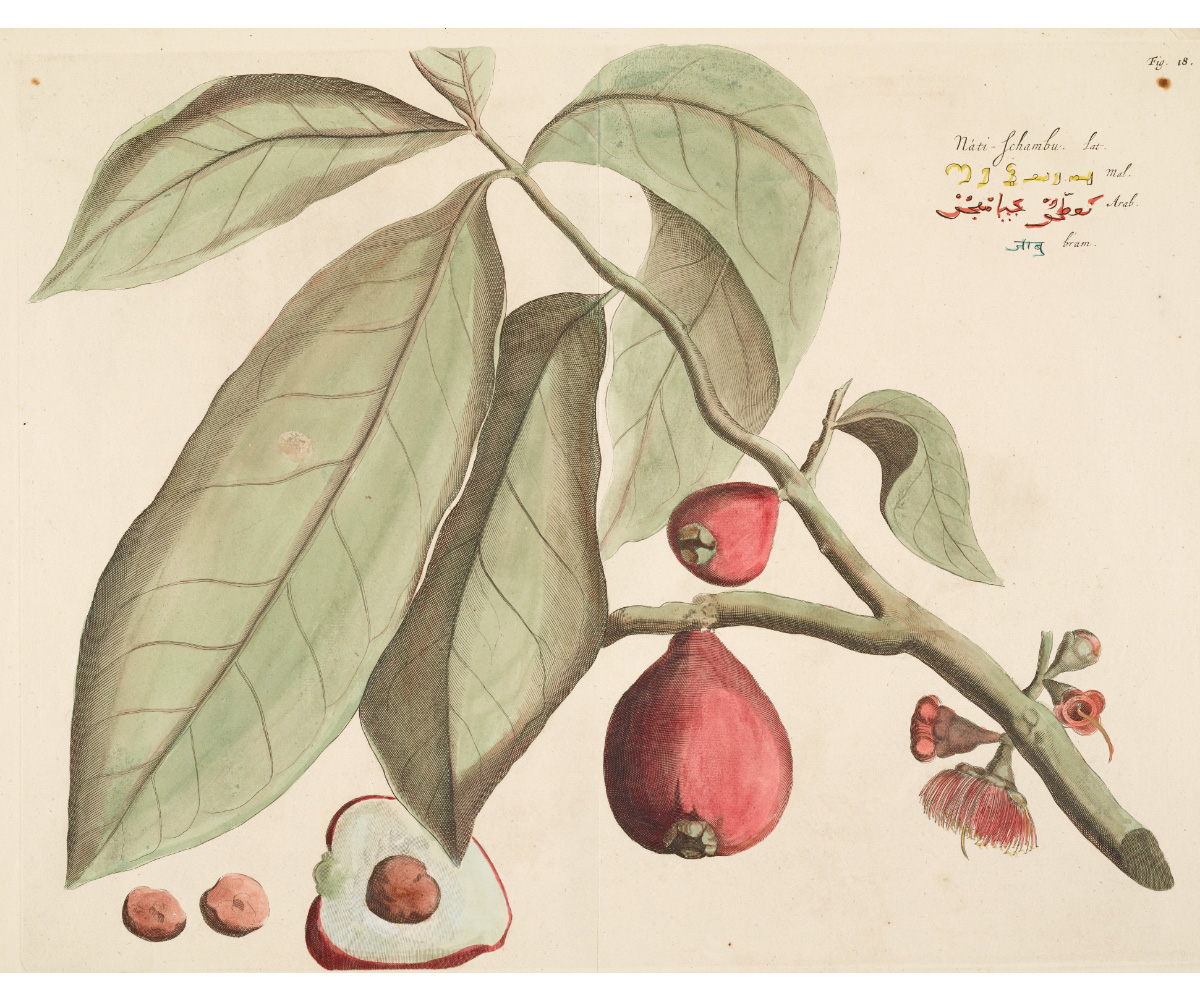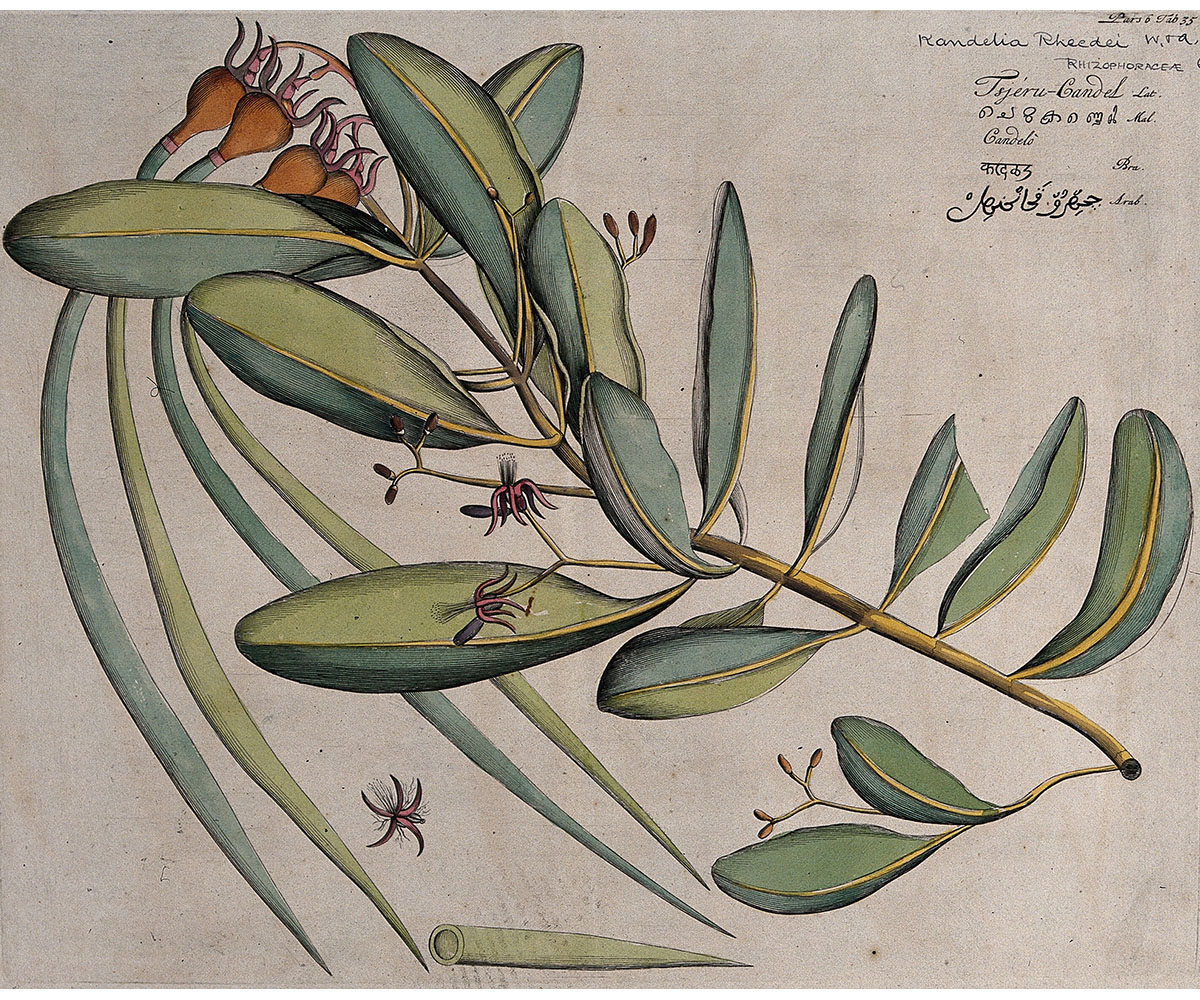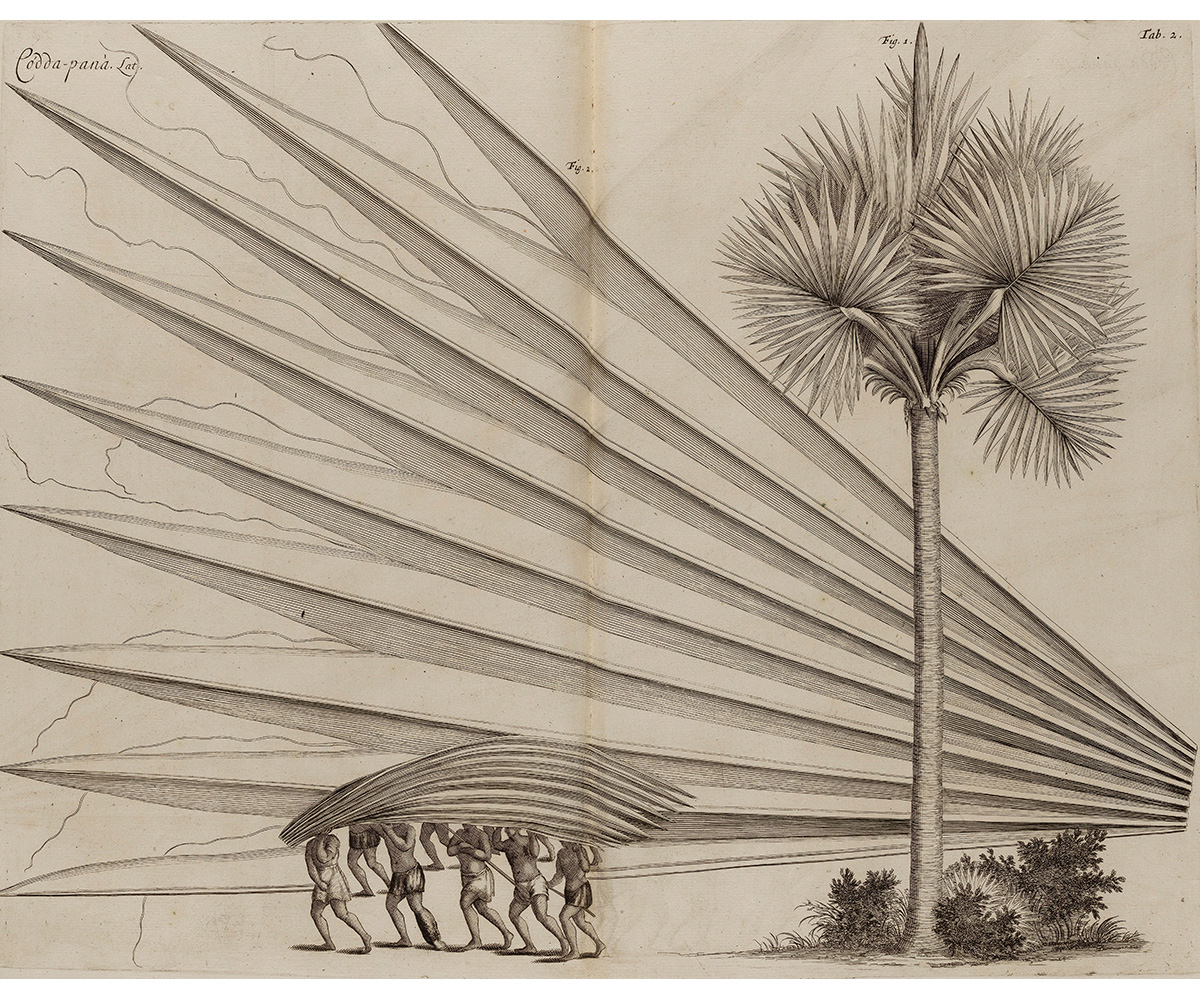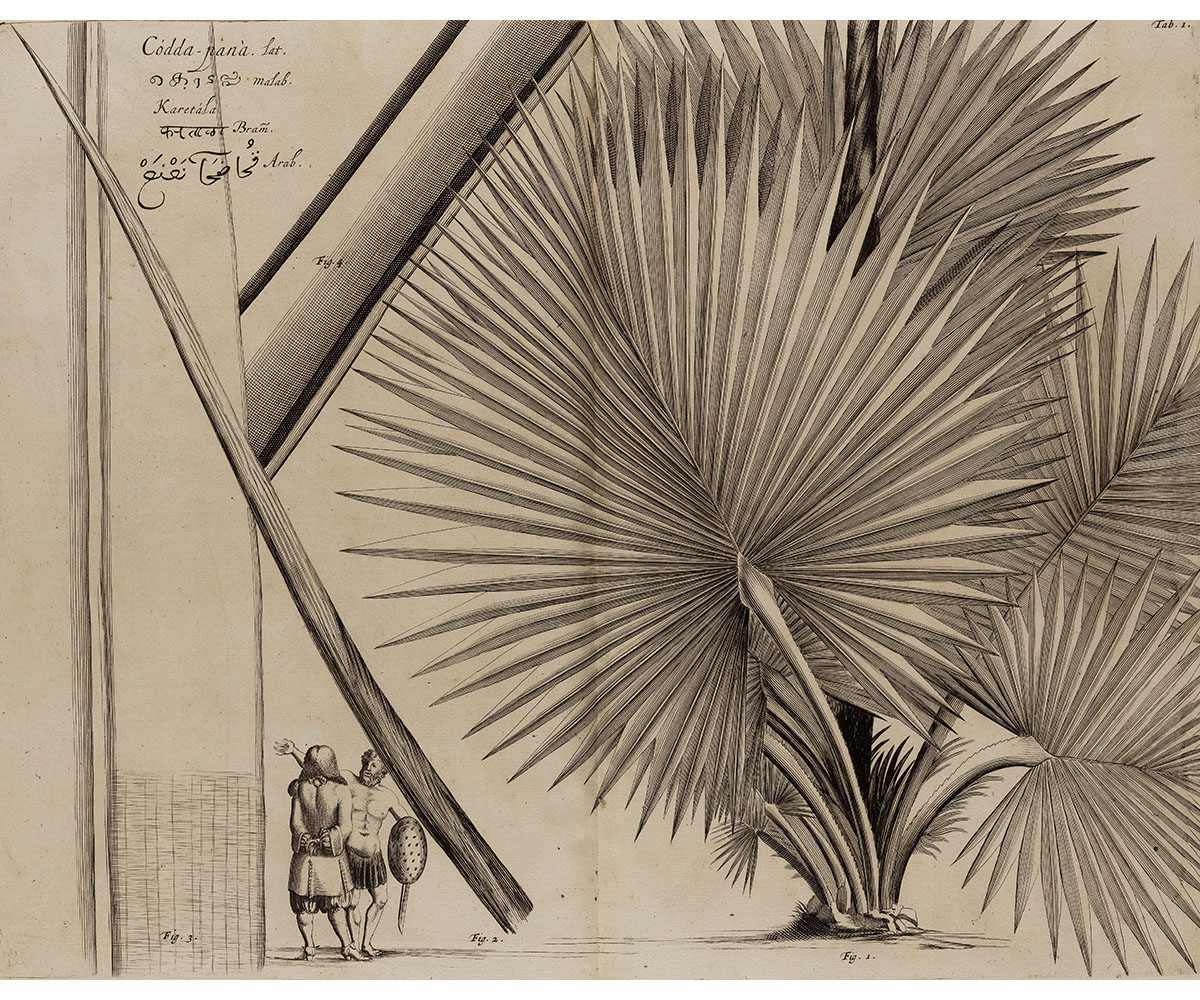PERSPECTIVES
Hortus Malabaricus — How the Garden of Malabar Travelled the World
Every land and field extending into the plains abounded so much with plants and trees of every kind, (as I have said of the above forests), and radiated such fertility… Indeed even the pools, and one may wonder about this, the marshes, nay the very borders of the rivers which carried salt water displayed several plants with which they were almost completely covered. There was no place, not even the smallest, which did not display some plants.
The most barren rocks abounded nevertheless with the splendour of a rich vegetation of trees and herbs.
– Hendrik Adriaan van Rheede tot Drakenstein, in his ‘Preface’ to volume 3 of Hortus Malabaricus
Facing the Arabian Sea along India’s southwestern coast lies a narrow strip of land over 800 kilometres long. Its inland edge is bounded by the Western Ghats, a continuous chain of mountains older than the Himalayas, which runs parallel to the coast. These mountains block the southwesterly winds coming over the Arabian Sea, bringing monsoon to its windward slopes and the long, narrow coast at its feet. This region, with its densely forested peaks, gurgling streams, cool valleys and fertile plains, is called Malabar — ‘land of the mountains’ — believed to derive from a combination of Dravidian and Arabic words. The Malabar region stretches from the Konkan region to Kanyakumari at the southernmost tip of the Indian subcontinent, and traverses five Indian states, most notably present-day Kerala. Its soil ranges from coastal alluvium to laterite and black cotton, and it hosts an astounding diversity of flora and fauna in its moist deciduous forests and rainforests, including several endangered plants and animals.
In the seventeenth-century, the trees and plants of this sliver of the Indian peninsula became the subject of an enormous Dutch-commissioned Latin compendium called the Hortus Malabaricus, the ‘Garden of Malabar’ published in Holland. Each plant was meticulously hand drawn and every detail catalogued. This is the story of how such a comprehensive treatise on these plants and their medicinal properties came to be published nearly 400 years ago — 8000 kilometres away from the land itself — and the particular set of local and global, economic and scientific circumstances that made it happen.
The land of riches: Trade, knowledge, power and healing
The monsoon winds that washed Malabar had, for thousands of years, also borne sailors from different parts of Asia to its coast. Traders, in particular, were attracted by the land’s rich produce, among which were timber, spices and food crops, as well as fine, naturally dyed cotton textiles. They thronged to the various ports that dot the coastline, establishing the region as an important point in the global trading network. In one of the most significant voyages of the ‘Age of Discovery’ (between the fifteenth and seventeenth centuries), the Portuguese explorer Vasco da Gama became the first European to sail to India. His arrival near the Malabar port of Calicut (present-day Kozhikode, Kerala) in 1498 had an unprecedented impact on the economics, politics and culture of not only the Malabar region but also the rest of the Indian subcontinent, and far beyond. From the sixteenth century onwards, Portuguese traders and other European merchant companies arrived on the shores of India, drawn not only by the lure of commerce but also the desire to possess and control land in areas critical to trade.
Beyond the economic riches it brought the region, the land of the Malabar coast also served its people as a healer. Its plains and forests nurtured plants that indigenous communities had used for medicinal purposes for generations. This accumulated medico-botanical learning had been passed down among traditional healers and codified into texts and other systems of knowledge, which in themselves became communal cultural heirlooms. The use of plants and plant-derived medicines in healing practices was not uncommon in ancient civilisations, whether in ancient Mesopotamia or Egypt. In the Indian subcontinent, the use of herbs for treating ailments found mention in the ancient texts of the Vedas and later in dedicated treatises on medicine like the Charaka Samhita and Sushruta Samhita.
In fifteenth-century Europe, even as overseas travel and trade networks were flourishing, a growing interest in botany, particularly the study of exotic tropical plants, was sweeping through the continent. From the late sixteenth century onwards, universities in Europe began establishing botanic gardens housing plants from different regions of the world, and exotic flora gained popularity as collectors’ items. While European nations vied for political power and control over profitable ports in newly discovered lands, they also competed for knowledge and the control it promised. Strategic knowledge of the natural world could be tapped for commercial and scientific purposes, and so the intimate understanding of foreign lands and their peoples became in itself a marker of power. In this context, indigenous expertise around natural resources began to acquire new layers of significance for explorers and the states funding their voyages.
Dutch Malabar: A garden discovered
By the mid-seventeenth century, the Dutch East India Company (Verenigde Oost-Indische Compagnie or VOC) had gained control of key islands and regions of maritime trade, particularly the spice trade, from the Portuguese. In 1663, they came to control parts of the Malabar region, particularly a significant territory in present-day Kerala, centred at Cochin. and in 1669 the second Dutch Governor of Malabar had been appointed — a man named Hendrik Adriaan van Rheede tot Drakenstein. By this time the networks of the VOC, spanning Southeast Asia, South Asia and South Africa, were already gathering knowledge about the natural environments of these regions, with merchants, officers, sailors and physicians all contributing information and specimens of flora.
In particular, the VOC government in Batavia (present-day Indonesia) had begun encouraging research into local medicinal sources in their Asian colonies and trading posts. The aim was to make these territories less dependent on medicinal supplies from the Netherlands, which were costly to transport and lost their efficacy over the course of the long voyages. They were exploring the potential for trade in medicinal plants from Malabar, which was predominantly associated with pepper. For van Rheede, this was also an opportunity to make a case for Cochin (present-day Kochi) as capital of the Dutch empire in Asia over Colombo.
It was against this backdrop that, in the 1670s, he assembled a diverse group of about twenty people to traverse the length of the Malabar coast to learn about its medicinal flora. The group, comprising administrators, physicians, artists and helpers, both Dutch and Indian, gathered and documented the leaves, fruits, flowers and seeds of nearly 740 plants in painstaking detail. Over three decades, their efforts, with the contributions of many others, led to the creation of the lavishly illustrated Hortus Indicus Malabaricus, published in twelve volumes between 1678 and 1693 in Amsterdam — a landmark work of tropical botany and taxonomy, and an object of sociocultural and anthropological significance even today.
Books and botany: In pursuit of plants
The Hortus Malabaricus relied on existing frameworks of local knowledge, drawing on generational indigenous wisdom of the land and the plants of the Malabar region. It was a significant work not only for the information it compiled, but also its intricate visual documentation of the astounding range of medicinal plants and trees that thrive on India’s southwestern coast. While it is perhaps the earliest publication of such breadth and detail on the flora of this part of the world, it was not the first European work to engage with South Asian ethno-botany.
A century before the first volume of the Hortus Malabaricus was published, the Portuguese physician Garcia D’Orta published his treatise Colóquios dos simples e drogas da Índia, or ‘Colloquies on the Simples [medicinal herbs] and Drugs of India’ in 1563. D’Orta had lived and worked in India for three decades, serving as physician for the viceroys of Portuguese India at Goa and later in the Nizam Shahi kingdom of Ahmadnagar. He had compiled his information from field research and local sources, as well as Arab physicians he encountered in the multicultural milieu of the sixteenth-century Deccan.
While D’Orta’s treatise was not illustrated, subsequent works that relied heavily on Colóquios — the Spanish Tratado de las drogas y medicinas de las Indias Orientales (1578) by Cristobal D’Acosta, and the Latin Aromatum et simplicium aliquot medicamentorum apud Indios nascentium historia (1567) by Carolus Clusius — carried a few woodcut illustrations of Indian plants. Another work, Jan Huygen van Linschotens’ Itinerario (1596) also carried botanical information on plant life in Goa. An unfinished English text, now known as the Gurney Herbal, likely compiled by a surgeon of the British East India Company in the mid-seventeenth century, included information on plants of the Coromandel Coast and northern Deccan regions. Another important work was the Viridarium Orientale, an illustrated work on South Asian plants compiled by a Christian priest, Father Matthew of St Joseph, who would also go on to contribute to the early version of the Hortus Malabaricus.
A Dutch governor, an Indian physician, and their motley crew: The making of the Hortus Malabaricus
Van Rheede himself was a naturalist, and he held a deep respect for the natural world, both scientifically and aesthetically. He was appreciative of the lush Malabar forests, with their diversity of plant life, and quickly came to realise that the soil of the region almost never lay fallow. His key guiding principle for the Hortus Malabaricus project was the quality of documentation — inspired by the thrust on empirical study that Europe was seeing at the time, he aimed to record accurate and detailed information from first hand sources.
He began by assembling a group of officials, physicians and botanists. Vira Kerala Verma, the VOC-installed ruler of Cochin, provided van Rheede with helpers to collect specimens for the project. A crucial figure in the project was Itty Acchuden, a vaidya or Ayurvedic physician from the marginalised Ezhava caste, who is believed to have selected the plants for the project. Hailing from the Collatt family of vaidyas, from Cherthala near Cochin, Acchuden was not only deeply knowledgeable about botany but had also inherited medico-botanical documents and works from his forebears. He was assisted by Ezhava helpers, who were familiar with the region’s biodiversity, could climb trees, and knew how to identify the various parts of the local plants. These plant specimens were brought to van Rheede and the artists, who drew from them from life, achieving accuracy from direct observation.
After the specimens were discussed and studied, the group compiled information about the plants, ranging from their nomenclature, habitat, odour, colour, taste, descriptions of their parts, and their fruiting and flowering seasons, to their importance in various industries and their use (or absence) in local medicinal practices. Three Brahmin physicians, Ranga Bhat, Vinayaka Pandit and Appu Bhat, who belonged to a dominant-caste community of priests originally from Goa and later settled in Cochin, also vetted the traditional medicinal uses of these plants using a fourteenth-century Sanskrit treatise called Manganingattnam or Maha Nighandu. The Malayalam names of the plants were recorded in the Kolezhuthu and Arabic scripts; the Konkani names in the Devanagari script; and the Latin names in the Roman script.
A number of Dutch collaborators worked with van Rheede. Two VOC officials, Johannes Casearius and Christiaan Herman van Donep helped translate information from the local languages to Portuguese, Dutch and Latin. Of the artists involved in drawing the specimens, only two names are known from the records — Antoni Jakobsz Goetkint and Marcelis Splintjer, both military draughtsmen of the VOC. In Holland, Bastiaan Stoopendael and Gonsalez Appelman and others created copperplate engravings based on the original drawings. Father Matthew of St Joseph, who had documented some of the region’s plants in Viridarium Orientale was originally a part of van Rheede’s team, but his drawings were rejected as they were not accurate.
A particularly significant aspect of the project was van Rheede’s collaboration with an Ezhava physician, and his decision to use a particularly indigenous system of classification. A rarity in a time marked by a rigorous belief in European scientific systems, this also brought recognition and respect to Ezhava indigenous systems, as the environmental historian Richard Grove points out. This framework was also able to bypass the often inaccurate information of the priestly Brahmin class. The inclusion of local nomenclature further served as windows into the socio-cultural contexts of the regions in which the plants grew. The Hortus Malabaricus described 740 species and carried 794 illustrations and remains the only encyclopaedic compendium that records Ezhava medico-botanical knowledge to such a great extent. Acchuden’s own documents — lost at some point — were never recovered.
Made in India, printed in Holland: In service to science
Seventeenth-century works like the Hortus Malabaricus and Georgius Everhardus Rumphius’ Herbarium Amboinense (which detailed the plants of the Amboina Island in modern-day Indonesia), filled critical gaps in botanical knowledge relating to Asia. These monumental works, combined with the collections and influence of botanic gardens of Leiden and Amsterdam, put Holland at the centre of tropical botany in the seventeenth century. Richard Grove frames Hortus Malabaricus as a symbol of the network of Dutch trade and science that connected Asia and Europe.
The Hortus Malabaricus was one of the main sources of information on Asian flora for Carl Linnaeus, and its taxonomic classifications based on Acchuden’s ancestral knowledge influenced Linnaeus’ Species Plantarum (1753), which listed and classified over 6,000 species of plants. It also influenced works by noted British botanists, such as William Roxburgh and Joseph Dalton Hooker.
Even as it is studied in institutions around the world, the Hortus Malabaricus has been brought back to life and relevance in Kerala of the present day. Its translation, annotation and research into the work have been a three-decade-long project for Indian botanist KS Manilal, who has in recent years produced English and Malayalam translations of the work, alongside multiple studies into its history and local contributors. Private not-for-profit and governmental institutions have created gardens with many of the species mentioned in the text. With these efforts, the Hortus Malabaricus and Acchuden’s role in its creation have also become significant cultural symbols of the sophistication of Ezhava medico-botanical knowledge.
The Hortus Malabaricus weaves in multiple strands into its legacy — from indigenous knowledge and its attribution to the networks of science and commerce in an expanding world of trade, political power and colonialism, technology, and shifts in perspective around the representation of nature in the visual arts. Above all, it is a story of the land, and of a curiosity to know and recognise the gifts of nature.
Bibliography
Cook, Harold J. Matters of Exchange: Commerce, Medicine, and Science in the Dutch Golden Age. New Haven: Yale University Press, 2007.
Grove, Richard. “Indigenous Knowledge and the Significance of South-West India for Portuguese and Dutch Constructions of Tropical Nature,” Modern Asian Studies 30, no. 1 (February 1996): 121–143. https://doi.org/10.1017/S0026749X00014104
Heniger, J. Hendrik Adriaan Van Reede Tot Drakenstein (1636-1691) And Hortus Malabaricus. Rotterdam: AA Balkema, 1986.
Jain, Akshai. “A Kerala Botanist’s Affair With an Unlikely 17th Century Book.” The Wire, September 30, 2018. Accessed April 14, 2024. https://thewire.in/the-sciences/hortus-malabaricus-van-rheede-ks-manilal-botany-itty-achuden
Menon, Minakshi. “Hortus Indicus Malabaricus: The Eurasian Life of a Seventeenth-Century “European” Botanical Classic.” Max Planck Institute for the History of Science, July 12, 2023. Accessed April 12, 2024. https://www.mpiwg-berlin.mpg.de/feature-story/malabaricus-botanical-seventeenth-century
Manilal, K. S. Hortus Malabaricus and the socio-cultural heritage of India. Calicut: Indian Association for Angiosperm Taxonomy, Department of Botany, University of Calicut, 2012.
Nair, Preethu. “In Kerala, a garden springs from a book.” Times of India, October 30, 2022. Accessed April 14, 2024. https://timesofindia.indiatimes.com/city/kochi/in-kerala-a-garden-springs-from-a-book/articleshow/95171587.cms
Nair, Savithri Preetha. “The Gurney Herbal.” Marg 70, no. 2 (December 2018–March 2019): 54-57.
Raj, Kapil. “Jardin de Lorixa.” Marg 70, no. 2 (December 2018–March 2019): 52-53.
Reddy, Sita. “Ars Botanica: Refiguring the Botanical Art Archive.” Marg 70, no. 2 (December 2018–March 2019): 14–23.
Reddy, Sita. “Hortus Indicus Malabricus.” Marg 70, no. 2 (December 2018–March 2019): 58-63.
Reddy, Sita. “Indian Botanicals and Heritage Wars.” Wellcome Collection, April 5, 2018. Accessed April 13, 2024. https://wellcomecollection.org/articles/WrUXjh8AAB4A1GXE
S, Priyadershini. “Taste the Malabar at Kochi’s newest cocktail bar Hortus.” Hindu, March 21, 2023. Accessed April 14, 2024. https://www.thehindu.com/life-and-style/food/hortus-the-garden-of-malabar-a-cocktail-bar-and-restaurant-in-kochi/article66531701.ece
Underwood, E. Ashworth , Thomson, . William Archibald Robson , Rhodes, . Philip , Richardson, . Robert G. and Guthrie, . Douglas James. “History of medicine.” Encyclopedia Britannica, February 16, 2024. Accessed April 13, 2024. https://www.britannica.com/science/history-of-medicine.




